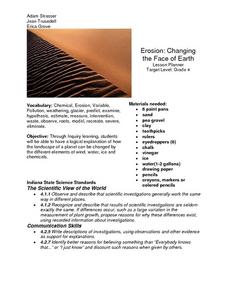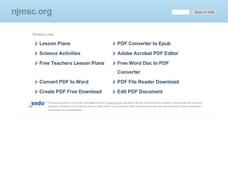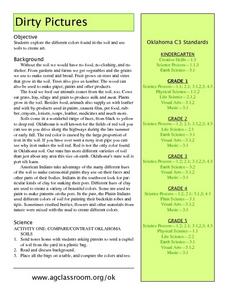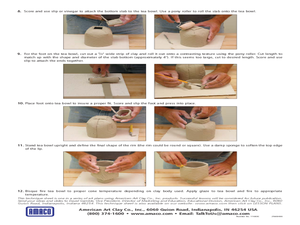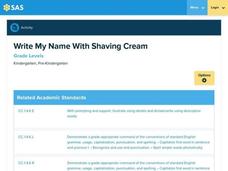Curated OER
Understanding Climate
Fourth graders create two dioramas out of household materials to compare the influence of various factors that impact climate. Each group discuss how the change in factors influenced the climate, flora, and fauna of their area.
Curated OER
Illnois River and Lake Mussel Habitat Diorama Activity
Students identify the environmental elements of river and lake mussels. They compare the elements to the time before settlement and during industrialization. They also participate in a field trip to a mussel exhibit.
Curated OER
Erosion: Changing the Face of Earth
Fourth graders explore how the landscape of the planet can be changed by different elements of wind, water, ice and chemicals through hands-on activities. They examine pictures of areas around town and discuss anything they think is out...
Curated OER
Lord of the Flies: Chapter 4 Reading and Study Guide
In this reading and study guide worksheet, learners define 8 vocabulary words, define 1 literary term, and respond to 24 short answer questions pertaining to chapter 4 of William Golding's Lord of the Flies.
Curated OER
ABC Fun and Letter of the Week Activities
Students explore the alphabet. In this language arts lesson plan, students develop their fine motor skills as they participate in activities that require them to identify the letters of the alphabet.
Curated OER
Fossil Evidence for Plate Tectonics
Learners draw maps of counties that were important to the discovery of plate tectonic theory. In this plate tectonics instructional activity students excavate constructed fossil sites from matching coastlines and discuss the possible...
Curated OER
Chemosynthesis in the Classroom
Students observe the development of chemosynthesis in bacterial communities. In this bacteria instructional activity students explore that chemosynthesis is and how it is relevant to biological communities.
Curated OER
The Glass House - Farnsworth House, Plano, Illinois
Students analyze the architecture of Ludwig van der Rohe's 'The Glass House.' In this architecture analysis lesson, students view the images of the house and read about the home. Students complete two research projects for the lesson.
Curated OER
Contrast- Printmaking- The Fin Art of Science
Learners explore the art of printmaking. They discuss relief prints and the art of fish printing (Gyotaku). They view examples of the artwork of Gyotaku and also observe the various characteristics of different species of fish. Finally...
Curated OER
Skates
Learners gain understanding of structure, characteristics, and basic needs of living things and their role in world, identify parts of skate, observe details of skate's body and skate egg case, and identify unique characteristics of skates.
Curated OER
Lead Detection
Students hypothesize whether the soil sample may have lead contamination and why. They describe what they see happening with the soil samples and the corresponding swabs. Pupils write a brief description of what they observe as the...
Curated OER
Currents: Bad for Divers; Good for Corals
Students describe, compare, and contrast major forces that drive ocean currents. They discuss the general effects of topography on current velocity. They discuss how velocity affects the ability
Curated OER
There Must Be Something in the Water
Students read a New York Times article as a class and discuss how groundwater near a nuclear test site may have been contaminated. They explore how groundwater contamination can spread through aquifers by participating in a simulation.
Curated OER
UMNH: The Fremont People
Third graders explore the Fremont people and then make their own Fremont-Style pottery.
Curated OER
Hatshepsut's Temples and Obelisks
Third graders create Hatshepsut's Temples and Obelisks using a variety of materials.
Curated OER
Point Source vs. Non-point Source Pollution
Students define and differentiate between point source and non-point source pollution. Students discuss various types of pollution including air, water and land pollution, analyze demonstrations and complete a worksheet.
Curated OER
Dirty Pictures
Students investigate how food, clothing and shelter come from soil after they examine soil from their own backyards. They map soils on the color wheel before making glue and soil pictures and tie-dying T-shirts in red soil.
Curated OER
The Appearance of the Moon
Third graders watch a demonstration on how craters were formed on the moon. Individually, they care given a set of materials that represent the moon surface and make their own craters. To end the instructional activity, they measure...
Curated OER
Social Studies: The Fremont People
Students examine the culture of the Fremont people prior to creating their own copies of their pottery. With teacher-supplied clay, students follow instruction sheets to make their own replicas based on the Fremont pottery designs.
Curated OER
Giving Back to our School Community
Students recognize that gifts can be for a community and not just for an individual. They acknowledge that helping to beautify our school community is a positive step in becoming a contributing citizen.
Curated OER
Hand Built Tea Bowls
Students follow directions to create clay bowls. For this pottery lesson, students use clay and the pictured tools to follow the directions and create a fire baked tea bowl.
Pennsylvania Department of Education
Write My Name With Shaving Cream
Students write their names using shaving cream. In this write my name lesson, students practice forming letters using shaving cream. Students follow appropriate conventions of print to convey a message and use spacing and letters correctly.




